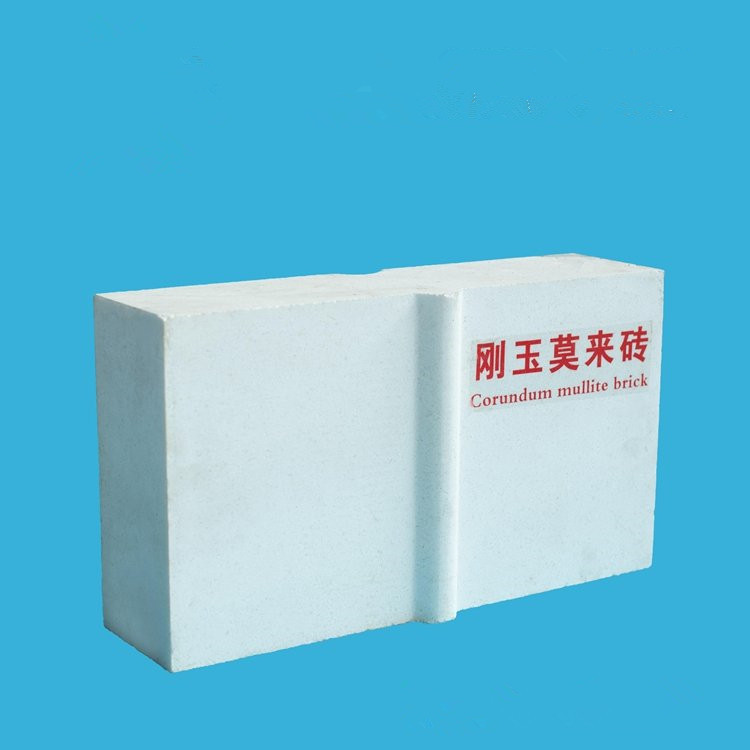Corundum mullite products
Corundum mullite products
Corundum mullite products
- Detail
- Parameters
Corundum mullite bricks refer to highalumina refractory products composed of the main crystalline phases of corundumand mullite. Corundum mullite bricks refer to refractory products made fromhigh-purity or relatively pure raw materials.
High quality corundum mullite bricks havegood high temperature strength, high temperature creep resistance, thermalshock resistance, and corrosion resistance. The physical and chemicalproperties of a typical corundum mullite brick are: Al2O3>85%, Fe2O3 0.45%,apparent porosity 19%, room temperature compressive strength greater than55MPa, load softening temperature greater than 1700 ℃, heatingline change (1600 ℃, 3h) -0.1%, and thermal shock resistance (1100 ℃ watercooling) greater than 30 times. Pure mullite raw materials synthesized fromindustrial aluminum oxide powder and pure clay, bauxite, or silica should beused, especially the content of alkali metal oxides should be as low aspossible. The products made from mullite particles as aggregates have good thermalshock resistance, but slightly poor corrosion resistance. Products usingcorundum sand as aggregate have good corrosion resistance, but slightly poorthermal shock resistance. Corundum mullite bricks are mainly used in hightemperature hot air furnaces, as well as glass furnaces and as ceramicfiring kiln furniture.
Mineral composition of corundum mullitebricks
Corundum mullite bricks are mainly made ofcorundum and mullite as raw materials, and are fired at high temperature in anoxidizing atmosphere by adding an appropriate amount of alumina, silicaultrafine powder, and additives. Its AL2O3 content ranges from 72% to 90%.
Production process of corundum mullitebricks
The corundum mullite brick body is formedusing a 300t friction press, with a body density of 2.7g/cm3. The body is driedin a tunnel dryer. The inlet temperature is 40-50 ℃, themaximum drying temperature is 130 ℃, the drying time is48 hours, and the moisture content of the green body is not more than 1.5%. Theproduct is fired in a tunnel kiln at a temperature of 1550 ℃ and aholding time of 10 hours.
Forming method of corundum mullite bricks
(1) Refractory products with complex shapesand larger sizes are formed by air hammer ramming or vibration.
(2) Ordinary products or standard sizes canbe formed using semi dry high pressure molding.
(3) Specially shaped pure or special productsrequire the design of molds and the use of isostatic pressing for forming.
Physical properties of corundum mullitebricks
The high-temperature main crystallinephases of corundum mullite bricks are corundum and mullite. The crystals ofcorundum are short columnar and barrel shaped, and do not intersect orintersect with each other in the refractory structure. The interlaced columnarcrystals of mullite are embedded between the corundum crystals, effectivelypreventing the slip of the corundum crystals and obtaining a stable structure.Due to the more stable crystal structure, it is more conducive to utilizing theexcellent properties of mullite or mullite and corundum. For example, themelting point is 1870 ℃ for mullite and 2050 ℃ for corundum, with a higher co melting temperature of 1840 ℃, which isconducive to improving and enhancing the high-temperature performance of the material.
Characteristics of corundum mullite brickproducts
(1) High temperature resistance, highrefractory temperature, and high load softening temperature.
(2) Resistant to chemical attack, withstrong resistance to acidic solutions or slag.
(3) Antioxidant. Not prone to chemicalreactions with gases such as O2, H2, CO, etc.
(4) Good thermal stability, stable volumeat high temperatures, and not easy to expand or contract.
(5) Good thermal shock resistance,resistant to rapid cooling and heat, and not easy to peel off.
(6) High room temperature compressivestrength, not easily worn during handling or unloading.
Scope of use of corundum mullite bricks
Corundum mullite bricks can directly comeinto contact with flames, resist peeling, and withstand high temperatures. They can be used as insulation lining for high-temperature industrial furnaces andas working layers for other industrial high-temperature kilns. They are mainlyused in the petrochemical industry,as materials for large and medium sizedsynthetic ammonia gasifiers and magnetic material gas furnaces, and assupporting facilities for high-temperature industrial kilns.
index | |
Al2O3% ≥ | 80 |
SiO2% ≤ | 18 |
Fe2O3% ≤ | 0.4 |
显气孔率 Porosity % ≤ | 18 |
体积密度 Bulk Density g/cm3 ≥ | 1.8~2.7 |
常温耐压强度 Clod crushing strength MPa ≥ | 90 |
耐火度 Refractoriness ℃ | 1790 |
荷重软化开始温度 Refractoriness under load ℃ ≥(0.2MPa,0.6%) | 1650 |
重烧线变化率 Permanent linear change % ≤(1600℃×8h) | 0.2 |
